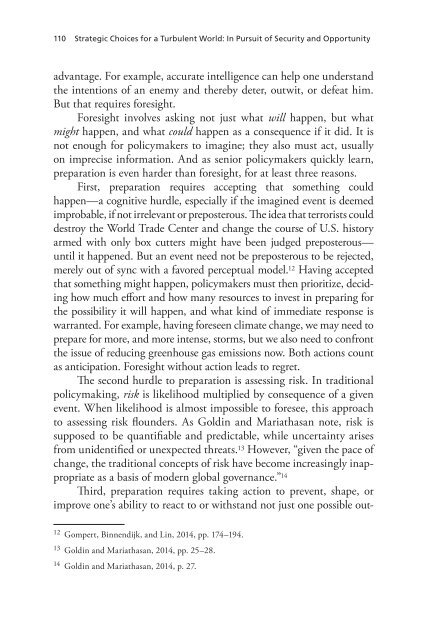You also want an ePaper? Increase the reach of your titles
YUMPU automatically turns print PDFs into web optimized ePapers that Google loves.
110 Strategic Choices for a Turbulent World: In Pursuit of Security and Opportunity<br />
advantage. For example, accurate intelligence can help one understand<br />
the intentions of an enemy and thereby deter, outwit, or defeat him.<br />
But that requires foresight.<br />
Foresight involves asking not just what will happen, but what<br />
might happen, and what could happen as a consequence if it did. It is<br />
not enough for policymakers to imagine; they also must act, usually<br />
on imprecise information. And as senior policymakers quickly learn,<br />
preparation is even harder than foresight, for at least three reasons.<br />
First, preparation requires accepting that something could<br />
happen—a cognitive hurdle, especially if the imagined event is deemed<br />
improbable, if not irrelevant or preposterous. The idea that terrorists could<br />
destroy the World Trade Center and change the course of U.S. history<br />
armed with only box cutters might have been judged preposterous—<br />
until it happened. But an event need not be preposterous to be rejected,<br />
merely out of sync with a favored perceptual model. 12 Having accepted<br />
that something might happen, policymakers must then prioritize, deciding<br />
how much effort and how many resources to invest in preparing for<br />
the possibility it will happen, and what kind of immediate response is<br />
warranted. For example, having foreseen climate change, we may need to<br />
prepare for more, and more intense, storms, but we also need to confront<br />
the issue of reducing greenhouse gas emissions now. Both actions count<br />
as anticipation. Foresight without action leads to regret.<br />
The second hurdle to preparation is assessing risk. In traditional<br />
policymaking, risk is likelihood multiplied by consequence of a given<br />
event. When likelihood is almost impossible to foresee, this approach<br />
to assessing risk flounders. As Goldin and Mariathasan note, risk is<br />
supposed to be quantifiable and predictable, while uncertainty arises<br />
from unidentified or unexpected threats. 13 However, “given the pace of<br />
change, the traditional concepts of risk have become increasingly inappropriate<br />
as a basis of modern global governance.” 14<br />
Third, preparation requires taking action to prevent, shape, or<br />
improve one’s ability to react to or withstand not just one possible out-<br />
12 Gompert, Binnendijk, and Lin, 2014, pp. 174–194.<br />
13 Goldin and Mariathasan, 2014, pp. 25–28.<br />
14 Goldin and Mariathasan, 2014, p. 27.




